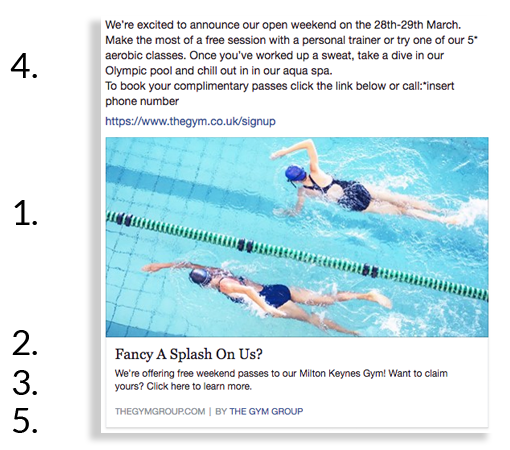The Anatomy of a Great Facebook Post
The Anatomy of a Great Facebook Post
Get weekly
HubSpot Updates
There are over 60 million Facebook pages all competing to capture the attention within a user's feed. Managing your organisation's social media presence can be pretty time-consuming, particularly if you’ve been tasked with it on top of another role.
With so much competition that can be a tall order, so it’s important to know that every piece of content you serve is optimised to the highest quality.
So, with both of these points in mind, we’re going to run you through the anatomy of a great Facebook post so you can create quality content efficiently.
Read More: 5 Social Media Myths Debunked
When creating a post, or indeed a content calendar, it’s important to ask yourself: ‘what’s the overall goal here?’ Are you trying to navigate a user to your website? Are you looking for consumer feedback or engagement? Are you simply trying to build awareness?
The answers to these questions will guide the creation of your Facebook post. Most of the time businesses’ posts use links to a site to encourage a user to learn more or take action. Link posts will be displayed vastly different to a post that just has an image. With that in mind, here’s how you should lay out a post with a link.
Posts including links will usually include a ‘link card’ as shown below. Interestingly, the first line of text isn’t the first place a user's eyes are drawn to. In fact, it usually goes:
1. Picture
2. Headine
3. Description
4. Post Copy
5. Source Link/Other
Picture
So let’s start from the top. You’ll want an image that is 1200x627 pixels. Facebook timelines are fickle things, and users don’t ever want to be sold too. So pick an image that you feel naturally might fall into their timeline.
If you can’t quite do that, make sure you don’t pick something bulging with text and isn’t obviously from a stock image site. For example, a gym looking to persuade users to click through to the website to sign up for a complimentary tour and session might pick a picture that showcases the facilities, for instance a hot tub or pool.
Headline
Next up you’ll want to decide on a short and snappy headline that gives context to your image and captures your users’ attention. Questions are great here, as they invite the reader to continue engaging with the post when they look for additional copy. For our example, we might pick:“Looking to Indulge in a Little Me Time?” or “Fancy a Splash on Us?”
Description
Once the users are engaged, they’ll look for a little more information. There's often some debate as to whether they bounce up to the post copy (Step 4) or whether they take a look at the copy underneath the heading. The truth is, it’s usually whichever has the most content. But, we’re all a little lazy and in practice we’re likely to look at the easiest thing to read in that moment. This is why I’d advise adding a few lines of content, directly under the heading. Following on from our example, we might choose:“We’re offering free weekend passes to our Milton Keynes Gym!. Want to claim yours? Click here to learn more.”
Post copy
Post copy is a great way to give more detail and add more context, and in some ways it is just as important as step 3 — a second line of defence in keeping a user’s attention. Make sure this piece highlights any key information you couldn’t initially fit in the shorter description..Using our example:
“We’re excited to announce our open weekend on the 28th-29th March.
Make the most of a free session with a personal trainer or try one of our 5* aerobic classes. Once you’ve worked up a sweat, take a dive in our olympic-size pool and chill out in in our aqua spa.
To book your complimentary passes, click the link below or call:*insert phone number*”
Source link
Finally, if a user hasn’t clicked through by now, they might take a look at the source link or the name of the page posting, which might encourage them to click on it.
It’s important to remember that these processes and decisions the user makes are almost subconscious. That’s why it’s so important to follow these steps in order to maximise your chances of getting the user to complete whatever goal you’ve set for that piece of content.
Got a question on how to set up a post for your business? Let us know!
Our content includes affiliate links. This means that we may receive a commission if you make a purchase through one of the links on our website. This will be at no cost to you and helps to fund the content creation work on our website.